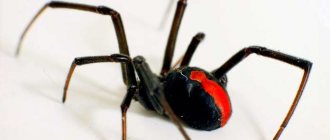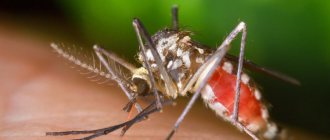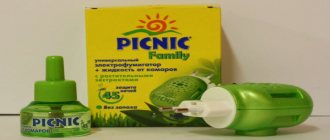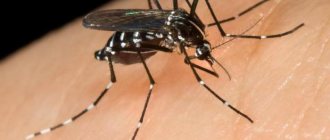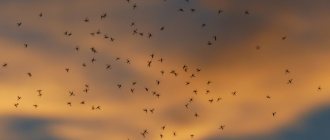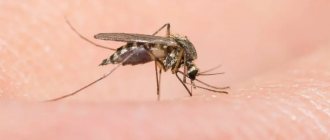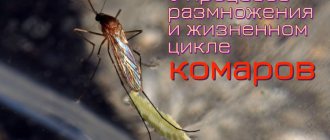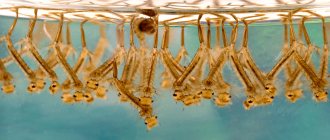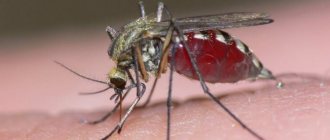During the warm season, everyone has encountered mosquitoes. Bloodsuckers spoil your vacation in nature, at the dacha, and prevent you from taking a normal walk in the forest or sitting near the lake. But it happens that in one area there are a lot of mosquitoes, but in another there are only a few individuals flying. What is this connected with? The activity of pests depends on the species, time of day and location. Some places attract bloodsuckers more strongly, for example, swampy areas, salt marshes, places where there is a lot of standing water, and excavator dumps. Let’s take a closer look at what mosquitoes like and don’t like in nature.
Air temperature
Mosquitoes don't like heat or cold. What weather do mosquitoes like? The optimal temperature for their life and development is +20 °C. But bloodsuckers are active already at +12 °C. The lower the temperature, the slower the insects develop and practically lose their ability to reproduce. Pests don't like high temperatures either. Why don't mosquitoes like heat? In the heat, their thin, weightless body dries out on the fly. But if you don’t see them in the city on a hot day, you should go hiking or fishing and have to fight off the insects.
If in the summer the air temperature stays above plus 25 degrees Celsius for several days, there are noticeably fewer mosquitoes.
Mosquitoes are afraid of the sun and hide in the shade of trees, grass, and bushes. But if they are disturbed, they will attack, despite the heat, especially since the dense foliage reliably protects them from the direct rays of the sun in the forest.
Some people think that mosquitoes love the heat, since they are active in the summer, but in fact this is not so, they do not like the sun and are even afraid of it.
In summer, the risk of attack is higher in the morning and evening. During the day they seek coolness and sit in shelters. There are species of mosquitoes that are active all night.
With the onset of cold weather, mosquitoes disappear. It cannot be said that mosquitoes are afraid of the cold, because they do not die, but spend the winter, entering diapause in the adult, pupal or egg stages.
Adult insects hide in tree hollows, animal burrows, tree trunk cavities and other places protected from the cold. Only females hibernate; nature has not given males such a privilege.
The eggs wait for warm days in the soil, mud at the bottom of reservoirs. Pupae are attached to aquatic vegetation or are also buried in silt and mud. After all, even in severe winters, only the top layer of reservoirs freezes.
In spring, as warm days arrive, the development of larvae continues. New individuals emerge from the eggs.
What temperature do mosquitoes not like? At temperatures from +16 to +25 °C they feel good. Temperatures outside this range negatively affect the life of insects.
Night activities
Mosquitoes fly out to hunt and search for plant food after sunset. They cannot stand sunlight, as bright rays cause them dehydration, leading to death.
Insects fly most intensively between 20-22 o'clock in the evening and at 4-6 o'clock in the morning. These watches are distinguished by comfortable conditions for them: temperature, atmospheric pressure and humidity take the most suitable values. At this time, females are able to travel 50 km in search of prey.
Towards noon, mosquitoes hide in damp, shady corners and remain there until it gets dark. Daytime rest allows them to remain active and, with fresh energy, begin to forage for food at night. Insects bite most intensely in the evening, and by morning the number of attacks decreases. A sleeping person or animal that does not feel the bites or resist is an ideal victim for a mosquito. Therefore, at night you should protect windows with mosquito nets and use fumigators.
Scientists have established an interesting fact: mosquitoes are most aggressive during the full moon. During this period, they become 500 times more active than usual.
Water, humidity
The presence of humidity is one of the main conditions for the development of mosquitoes. Why do mosquitoes love humidity and dampness? Insect larvae develop in damp soil or water. In dry conditions, the population size decreases significantly. Therefore, pests live in colonies along the banks of rivers, lakes and swamps.
In summer, in warm and damp weather, mosquitoes breed at a high rate. In two weeks, the insect goes through all stages of development.
The larvae even overwinter in the water; development is completed at +15 degrees, then they move to the shore.
Why mosquitoes love water is because it is a medium for raising offspring. The larvae, after emerging from the egg, feed on microorganisms in the water. They hang upside down above the surface, and swallow air with a special tube. After the larva becomes a pupa, it also spends all its time in the water. Insects come to land in the imago stage. They inhabit coastal vegetation and swarm near the breeding site.
Bloodsuckers are not picky about the quality of water; the more microorganisms, the more food, but the best conditions are swamps, where water fluctuations are minimal.
Not only ponds and swamps are suitable for mosquitoes to breed; these can be areas with a small amount of water.
Extending the hatching process
This is possible with a combination of antifreeze produced by the pest’s body and the presence of natural shelter. Eggs and larvae are distinguished by the property of delaying their own development in the event of unfavorable conditions.
Also, in autumn, females specially lay their last clutch of eggs in a protected area in order to ensure a safe wintering.
The eggs are incubated until the temperature is safe for the larvae to hatch normally. Because of this, we are faced with the emergence of a new generation of mosquitoes and midges every spring.
Lighting
Do mosquitoes like light or darkness? This question cannot be answered unambiguously. Many species of mosquitoes are active after dark, and during the day they hide from the sun in shelters, as they are afraid of drying out and dying. It's not the lighting, it's the heat.
Light attracts mosquitoes, but not bright sunlight. During the day they prefer to hide in the shadows, and become more active at dusk.
Are female mosquitoes afraid of light? After all, it happens at night, a mosquito squeaks above your ear, but as soon as you turn on the light, it immediately disappears. This is not a fear of light, but a reaction to changing lighting.
Moreover, it has been noticed that insects tend to fly out of the twilight towards the light. However, they are more attracted to the heat emitted by the light source. For example, they see a fire in infrared radiation as a source of food. But the smoke from the fire will keep pests away. Only females fly to the light; males are not interested in it.
When going fishing at night or in the forest to pick mushrooms, take with you repellents, essential oils that insects do not like, and use folk remedies. After all, mosquitoes are not afraid of people; we are a source of food for them.
Features of insects
Mosquitoes belong to the order Diptera because they have two pairs of wings. The posterior ones are called “haleteres”. The heads of insects are equipped with long antennae of 6 or more segments. Males have feathery antennae with a large surface, which helps them detect females ready to mate.
The oral apparatus of insects is a case in which two pairs of jaws are hidden. In females, they are equipped with thin teeth, with which insects pierce the skin of their victims. Males drink plant sap and eat pollen; their jaws are not designed for obtaining blood.
There are 100 species of mosquitoes in Russia. The most common 3 blood-sucking species are:
- Real mosquitoes (culexes). This is an insect 4-10 mm long with two wings. A species of culex, the common mosquito, lives in forests and cities.
- A biting mosquito reaching 7 mm in length. It is distinguished by its original color - white stripes on its legs and body. The insect lives in the southern regions, mainly in forests.
- A malaria mosquito that carries dangerous parasites - malarial plasmodia. It is similar in appearance to the Culex, but has longer legs and antennae.
Wind and rain
What mosquitoes are afraid of outdoors is strong winds. In nature, most species of bloodsuckers fly at a level of 10-15 meters above the surface of the earth, as they feed on the blood of animals. But the wind can carry their tiny bodies long distances.
So, if you need to build a hunting hut in the forest, it is better to choose a clearing that is well blown by the winds.
But mosquitoes are not afraid of rain, contrary to popular belief. Insects successfully move under raindrops. Only heavy rainfall can force them to take cover, otherwise walking in the rain can be deadly.
Where do insects come from in apartments in winter?
The urban mosquito is a product of urbanization. It appeared due to the growth of cities and the construction of multi-story buildings. Unlike its relatives - ordinary mosquitoes, the urban bloodsucker does not hibernate. It remains active all year round, bites people and breeds.
Urban mosquitoes do not need a swamp or river to reproduce. They lay eggs in basements, near wet water pipes. Parasites fly into apartments through ventilation shafts, open doors and windows.
Sounds
What sound do mosquitoes not like? Insects are repelled by the sound of the rustling wings of a dragonfly and the sonar of bats. Natural predators of mosquitoes eat them in large quantities. Studies have been conducted, one bat eats more than six hundred mosquitoes in an hour. It is not surprising that the sounds that predators make scare away insects. The same applies to birds; no studies have been conducted, but experts say that the tit eats insects equal in weight to its own.
Thus, ultrasonic repellers imitate the sounds of predators. The creators of the devices say that mosquitoes do not like a frequency of 30 kHz; it plunges them into panic.
It remains a mystery whether ultrasound actually works on mosquitoes. But in any case, the sound of danger scares away animals and insects.
Facts about mosquito weight
The common pest weighs only 3 g when hungry. The female feeds on blood in order to replenish protein reserves, which are needed for the formation of eggs.
Interesting!
At one time, the female individual drinks about 5.2 mg of blood, the number of bites varies depending on the actions of the victim. The mass of the mosquito doubles, the abdomen expands, and acquires a red tint. Food is digested within 2 days. During this time, up to 200 eggs are formed in the female’s abdomen. The laying is done one at a time in reservoirs with standing water.
Color
Scientists from America conducted a strange study that actually turned out to be useful. They tracked the mosquitoes' reaction to colors. They found out what color mosquitoes (and maybe midges) don’t like. As a result of the experiment, it turned out that the insects did not approach people wearing yellow clothes. They are not attracted to all shades of green.
But, mosquitoes love red, blue and black. Due to poor vision, it is easier for them to find dark silhouettes.
Knowing what color mosquitoes like, you can protect yourself from bloodsuckers without repellents. It is enough to choose clothes of suitable shades.
Parasites in the northern regions
Although mosquitoes are common throughout Russia, the largest number of them are found in Siberia. Bloodsuckers living in the northern regions, as a result of evolution, have acquired incredible frost resistance. Their females and eggs hide under ice and snow in winter.
When the summer sun warms the tundra, vast swamps form in many places. Clouds of hungry insects fly out of them, looking for food. This is a difficult time for people and animals. The main victims of bloodsuckers are caribou, but they also readily attack people.
Mosquitoes penetrate under clothing and into shoes, and violently attack areas of unprotected skin. Hordes of vile creatures can drive unprepared people to despair.
Vegetation
For rest and shelter, insects use the dense foliage of trees, tall grass, and shrubs. They are attracted to various weeds. But there is a tree that mosquitoes do not like; they are afraid of it. This is a tree with a pungent odor of fruits or inflorescences.
Mosquitoes avoid:
- Rowan
- Bird cherry
- Walnut
- Elderberry
- Conifers.
There are plants that lure insects with their scent and destroy them. These are plants that are predators - butterwort, sundew, flycatcher, dewweed.
Flowers that mosquitoes do not like are calendula, geranium, ageratum.
Insects do not like the smell of grass with a pungent aroma. Mosquitoes and midges do not like this. For the same reason, mosquitoes do not like the smell of vanilla. Vanilla-based folk remedies for repelling mosquitoes have been successfully used, which can be used both at home and outdoors. These are essential oils, sticks or confectionery powder. Mosquitoes do not like vanillin, but use it with caution; you may develop an allergy to vanilla.
Habitat
Culex pipiens is of African origin. Over the past 7 centuries, this species has spread throughout the world. In Russia, the common mosquito is found in all regions except the Arctic. In Northern Europe, Culexes are found everywhere except Iceland. Mosquitoes are especially fond of areas with a humid temperate climate and a large number of bodies of water. In many regions, insects behave more aggressively and form huge populations. In the taiga, where the bloodsucker lives in large numbers, people often suffer from massive bites. The only chance to get rid of mosquitoes for residents of taiga villages is to purchase gas traps for the mass destruction of bloodsuckers.

